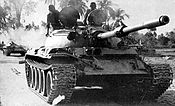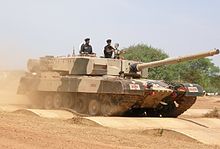- Cold Start (military doctrine)
-
Cold Start is a military doctrine developed by the Indian Armed Forces in 2004.[1] It involves joint operations between India's three main services Army, Navy, and Air Force and integrated battle groups for offensive operations. A key component is the preparation of India's forces to be able to quickly mobilize and take offensive actions.[2] Keeping in view the perceived inability of the Indian military to leverage its conventional superiority to end Pakistan's proxy war in Kashmir, the Cold Start doctrine is intended to allow it to mobilize quickly and undertake limited retaliatory attacks on Pakistan, without crossing nuclear threshold. [3]
This doctrine marks an significant change in defensive doctrine that India has followed since 1947. Requiring combined arms operating jointly with the Indian Air Force, Cold Start represents a significant advance in India's conventional military capabilities. Military exercise aimed at reducing mobilization time and rapid thrust, combined with advances in the area of network-centric warfare are undertaken to facilitate it, though the doctrine remains in the experimental stage.[4]
Contents
Origin of Cold Start Doctrine
India, since 1947 followed “a non-aggressive, non-provocative defense policy based on the philosophy of defensive defense.” [5] The defense policy was centered around 'holding corps' to halt the enemy advance. The weakness of this policy became evident when on 13 Dec 2001, India's Parliament was attacked by terrorists. India launched Operation Parakram but it took nearly a month to mobilize and by that time sufficient international pressure was built to stop India from launching a retaliatory strike.
Drawing from successful use of Blitzkrieg like techniques in Arab Israeli war of 1967[6] and Indo-Pakistani war of 1971 a doctrine was envisioned for specific needs of limited and rapid armored thrusts ,supported with infantry and air-force, from multiple points simultaneously.[7]
Development of Cold Start doctrine
A leaked US diplomatic cable disclosed that it is intended to be taken off the shelf and implemented within a 72-hour period during a crisis.[8] A positive attribute of Cold Start from the Indian perspective is that the short 72-hour time period between decision and attack could shield the Government of India from international pressure to refrain from taking military action against Pakistan as was the case in Operation Prakram of 2002.
In order to avoid the Indian Army's slow and lumbering military mobilization process and preserve the element of surprise in attack, Cold Start attacks could begin within 72 hours after the attack order has been given, and would be led by armored spearheads launched from prepared forward positions in Punjab and Rajasthan.
The plan emphasizes speed and overwhelming firepower: armored formations and accompanying infantry would advance into eastern Pakistan with limited goals in terms of distance and in terms of duration. Although the plan reportedly has a significant air support component, its scope remains unclear. From the Indian perspective, the unimplemented plan has the added virtue of accentuating Pakistani discomfiture and angst, which in theory may have some deterrent value.
Pakistani Response
Pakistani Army Chief Declared 2010 "Year of the training".Pakistan further conducted a large scale military exercise name Azm-e-Nau 3 focusing on their capability of offensive defense in case of cold start and tested [9][10]Nasr , an nuclear-capable solid fueled missile of 60 km range, to dissuade India from following Cold-start doctrine[11]. Institute for Defence Studies and Analyses stated that the development of Nasr indicates that Pakistan views India’s Cold Start doctrine with concern and that the Nasr is meant to deter India’s launch of Cold Start. It added that the net result would be "further nuclear impact(s) on Pakistani territory."[12] However Indian Air Force chief PV Naik stated that tactical missiles wont affect decision as "Tactical or strategic, it is a nuclear weapon. So, obviously our response would be absolutely violent as per our existing policy."[13]
On May 12 2011, India launched Operation Vijayee Bhava (blessed to win) an massive defense exercise involving 50,000 troops [14] in Bikaner and Suratgarh near the Pakistan border in order to boost the synergy between the defence forces. [15] Its main objective was to cut down mobilization time of military, which took 27 days to mobilize during Operation Prakram. The Indian Army confirmed that exercise was successful and it has reduced its mobilization time drastically to 48 hours. [16] [17] [18] In July 2011 an new solid fueled tactical ballistic missile Prahaar, of 150 km range, was tested. [19] The highly mobile Prahaar would provide the Indian army’s invading battle groups with lethal fire support. [20]
Criticism
There have been Following criticism to this strategy:
1.It may result in declaration of Total War and General Mobilization by Pakistan.
2.Publicly announcing the "Cold Start" strategy is self contradictory takes away the element of surprise and defeats the purpose.
3.Although the plan reportedly has a significant air support component, it is unclear to us how much joint versus parallel planning has taken place. No mention of a major operational role for the Indian Navy or parallel sea-launched attacks. Pakistan has clearly announced comprehensive use of Air power and Air Defence in case of a Cold Start during Azm e Nau 3 along with an announced Naval offensive strategy.
4.The unimplemented plan has the added virtue of accentuating Pakistani discomfiture and angst, which in theory may have some deterrent value.
5.The precise function of the Cabinet Committee on Security in ratifying decisions to take military action, the character of the military's advisory responsibilities to the Cabinet, the possible ad hoc nature of decision-making in the upper levels of the Indian government and the role of Congress Party figures like Sonia Gandhi in this process are not clearly understood.
6.It is not implementable statistically[21].
7. The concept of Shahadat may compel Pakistani paramilitary,armed civilians,Mujahideen and Military Units to fight till death creating tough pockets of resistance wasting time crucial to the doctrine.
8.Although Cold Start is designed to punish Pakistan in a limited manner without triggering a nuclear response, they can not be sure whether Pakistani leaders will in fact refrain from such a response. [22]
Further Reading
- WikiLeaks: US on Indian Army's Cold Start Doctrine[23]
References
- ^ http://www.southasiaanalysis.org/%5Cpapers10%5Cpaper991.html
- ^ http://www.indiatogether.org/2004/may/fah-coldstart.htm
- ^ http://belfercenter.ksg.harvard.edu/publication/17972/cold_start_for_hot_wars_the_indian_armys_new_limited_war_doctrine.html
- ^ The Indian Army's New Limited War Doctrine
- ^ http://www.stratmag.com/issueOct-15/page07.htm
- ^ http://www.globalsecurity.org/military/world/war/indo-pak.htm
- ^ http://www.southasiaanalysis.org/%5Cpapers10%5Cpaper991.html
- ^ "10NEWDELHI295, COLD START - A MIXTURE OF MYTH AND REALITY". Wikileaks. 2010-02-16. http://www.wikileaks.nl/cable/2010/02/10NEWDELHI295.html.
- ^ http://www.chowrangi.com/azm-e-nau-3-largest-military-exercise-by-pakistan-army.html
- ^ http://www.pakistankakhudahafiz.com/2010/05/30/azm-e-nau-hot-start-against-cold-start/amz-e-nau3/
- ^ http://www.indianexpress.com/news/paks-hatf9-missile-aimed-at-indias-cold/778736/
- ^ http://idsa.in/idsacomments/MakingSenseofNasr_aahmed_240411
- ^ http://timesofindia.indiatimes.com/india/Response-to-strike-from-Pakistan-will-be-massive-IAF-chief/articleshow/9370406.cms
- ^ http://connect.in.com/india-vs-pakistan/news/exercise-vijayee-bhava-to-transform-army-into-more-agile-force-1955597-dfafe4d99582fc98cc96f84a017a8dfdcf4b35ee.html
- ^ http://in.news.yahoo.com/exercise-vijayee-bhava-boost-synergy-between-armed-forces-105205242.html
- ^ http://www.defencenews.in/defence-news-internal.asp?get=old&id=469
- ^ http://article.wn.com/view/2011/05/15/Army_mobilisation_time_48_hours/
- ^ http://epaper.dnaindia.com/dnaahmedabad/epaperpdf%5C16052011%5C15ahm%20main%20edition-pg6-0.pdf
- ^ http://daily.bhaskar.com/article/NAT-IRS-india-conducts-first-test-launch-of-short-range-ballistic-missile-prahar-2281389.html
- ^ http://www.business-standard.com/india/news/armys-cold-start-doctrine-gets-teeth/443539/
- ^ http://mjoshi.blogspot.com/2010/02/who-is-afraid-of-cold-start-certainly.html
- ^ http://www.ndtv.com/article/wikileaks-revelations/wikileaks-us-on-indian-army-s-cold-start-doctrine-69859?cp
- ^ http://www.ndtv.com/article/wikileaks-revelations/wikileaks-us-on-indian-army-s-cold-start-doctrine-69859?cp&cp
Categories:- Military doctrines
- Military of India
Wikimedia Foundation. 2010.


